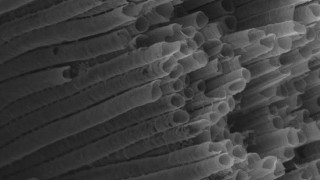Jun 11 2015
Researchers in UC’s Department of Cancer Biology are collaborating with material scientists from the University of Houston to create and use nanotubes to capture and understand the regulation of proteins involved in a variety of diseases including certain cancers, cardiovascular diseases and obesity.
 Scanning Electron Microscopy (SEM) of titania nanotubes. Credit: University of Cincinnati
Scanning Electron Microscopy (SEM) of titania nanotubes. Credit: University of Cincinnati
A recent study, published in the American Chemical Society Applied Materials & Interfaces journal, showed that titanium nanotubes grown on titanium-based metal wire provided efficacy for enrichment of phosphopeptides, the key regulation mechanism behind normal biological and cellular functions, and were easier to use, which could mean lower costs and more practical material use in scientific studies.
"Protein phosphorylation is a central regulatory mechanism for functions within the normal cells and biological processes in the body, while disruption of phosphorylation can lead to the initiation of a variety of diseases including cardiovascular, neurological, endocrine and cancer,” says Ken Greis, PhD, associate professor in the Department of Cancer Biology, member of both the UC Cancer Institute and the Cincinnati Cancer Center and co-author on the study.
"Studies aimed at understanding the dynamics of phosphorylation have come to the forefront of biological research as the research community attempts to understand the underlying cellular mechanisms of disease with the goal of providing new targets for therapeutic intervention.
Greis says the study of cellular phosphorylation of proteins (or phosphoproteomics) is typically done by separating and categorizing the proteins by liquid chromatography and mass spectrometry. Enrichment by adding metal materials is needed to help with this separation.
"Mesoporous titania particles are widely used for phosphopeptide enrichment but are expensive and offer very limited opportunities for improvement in function,” he continues. "Titanium dioxide (commonly known as titania) nanotubes grown on titanium wire have shown promising characteristics for phosphopeptide separation. In this study, we evaluate the efficacy of nanotubes on titanium wire for phosphoproteomics research.”
Researchers used titanium wire based titania nanotubes and compared results when commercial particles were used on a set of known standard phosphopeptides and then on hundreds of phoshophopeptides derived from animal liver tissue.
"Our studies revealed that the titania nanotubes on metal wire provide comparable efficacy for enrichment of phosphopeptides and easier use when compared to the particles. This could reduce costs and be a more effective method for future studies,” Greis says. "The ability to vary the length and the size of the nanotubes also opens the door to further development of the enrichment technology. This is truly an exciting collaboration which also highlights the benefit of scientific interactions across disciplines.
"This interaction was initiated by a discussion between postdocs at the two institutions and has blossomed into a fruitful collaboration with professor Oomman Varghese, who is a leading expert in technologies, to generate and develop titanium nanotubes for use as chemical sensors and for solar energy conversion technologies at the University of Houston. Now, we are combining our expertise to design and test new enrichment materials to further enhance our understanding of phosphorylation changes in disease to help us in the fight against cancer and other maladies. It shows great promise.”
Varghese is an associate professor in the department of physics at the University of Houston. Other authors on the study include Aruna Wijeratne, PhD, postdoctoral fellow in Greis’ lab at UC, and Wei-Kan Chu, distinguished university professor; Dharshana Wijesundera, PhD, postdoctoral fellow; Maggie Paulose, research scientist; and Ivy Belinda Ahiabu graduate student, all in the University of Houston physics department.